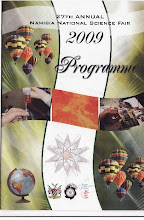We went west to the Atlantic coast this past weekend. There are two really neat towns that attract a lot of visitors--Swakopmund and Walvis Bay. It's about a 4.5 hour drive from Windhoek, but well worth the time and effort given that it's two lane roads most of the way. They are, however, tarred (paved) and that's a plus. The road takes the driver through the Namib dessert. It was fascinating watching the terrain change from greenery to absolutely no vegetation whatsoever. We saw a wonderful array of birds along the way and other wildlife. Swakopmund was founded by the Germans, so their mark on the architecture and the layout are still very evident. The streets are lined with palms and every thing is neat and tidy. We visited the National Aquarium which sits right on the beach. It is small but has a nice collection of sea life. Emma got to touch a giant sea turtle's flipper because the top is open and the animals come to the surface to view the people as much as the people come to view them. Afterwards, the kids chased the waves on the public beach. Of course they ignored our warnings about staying dry and by the time we got them into the vehicle, they were soaked. We still had a bit of a ways to go to get to the place where we were staying in Walvis Bay. Walvis Bay is right on the water as well, but the swimming isn't so good there because it is rather muddy. This though is perfect for the flamingos that wade out in the bay searching for things to eat. We stayed at a bed and breakfast called Lagoon Loge run by a French couple. Our room looked out on the bay with the wading flamingos and was cooled by the breeze off the ocean--no a/c. Madame Hélène's dog Jacques played fetch with the kids until the kids got tired. They wanted to take him home, but he had too much energy even for the kids.
On Sunday morning, bright and early, just after enjoying Madame Hélène's delicious breakfast, we set out on a boat tour of the bay. The guide was very well versed and kept it interesting for the 4 hour ride. The winds were calm and the water was like glass. It was truly perfect weather for such an outing. When we arrived, Spotty, a cape fur seal, welcomed us at the dock. He apparently "works" for the tour company. Very gentle, the girls were able to pet him and touch his flippers. He joined us on the boat as well as once we got underway. He just shoots right out of the water and onto the boat and sits right where he wants to. They are such intelligent creatures that he understood commands much like a dog even though he is very much a part of the wildlife of the bay. The pelicans were probably the most entertaining, nonetheless. They would swallow the guide's arm up to his armpit when he tried to fed them. They'd follow the boat when it took to the water and one even landed on the prow while the boat was accelerating away. I'm going to try to upload the video we took, but I'm not sure it'll work, so a picture may have to be posted instead. We visited the oyster farms, seal colony, and cormorant guano platform--yes they harvest the bird poop here to be used in the manufacture of women's cosmetics (Yuck!). We also got to see two types of dolphins, but they were proving to be rather elusive and not interested in playing although we tried hard to follow them. While out in the bay, the guide cracked open a couple dozen oysters and pulled out a couple of platters of hors d'oeuvres which we ate greedily. We also sipped on a few bottles of champagne. The oysters were the best Reid and I have ever eaten. Since the waters here are colder than in Louisiana, there's no fear of bacterial contamination and we ate more than our fair share. Fortunately, there was a bottle of Tabasco to accompany the oysters and we made sure that everyone on the boat knew that Tabasco was produced in our home state.
On the way out of Walvis bay, the kids wanted to get some time in the ocean, so we pulled down one of the paths and took the RangeRover over the dunes to the sea. We had a grand ole time getting over the dune, which was fun, but made us a bit nervous about getting back up the same way we came. A little anxious about getting stuck, we decided to follow some fishermen back down the beach toward Walvis Bay and get back onto the main road the easy way even though Ole Bess could have probably handled it! It was an awesome interlude and we're giving some thought to buying a little place there where we could retire. Of course the locals say that it can get really ugly there when the winds come off the ocean and stir up the sands or when the mist crawls in and lingers for days. How fortuitous that we picked the right weekend to visit when the weather was just perfect!









